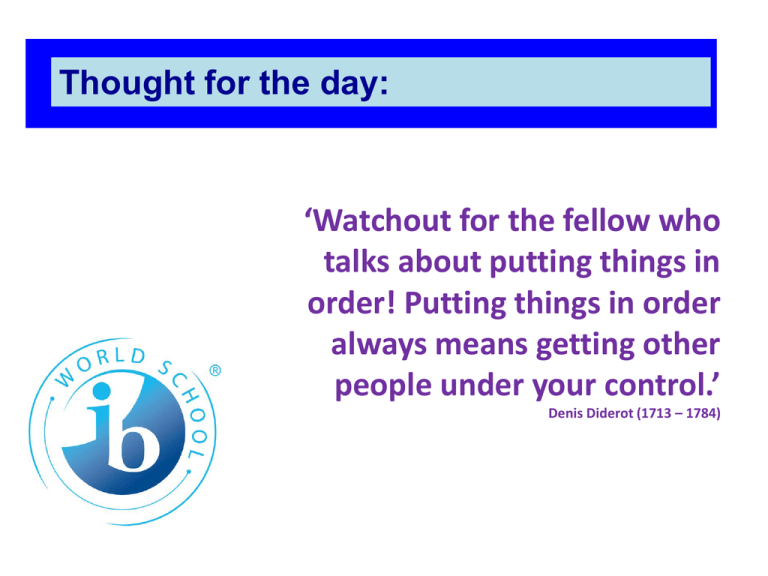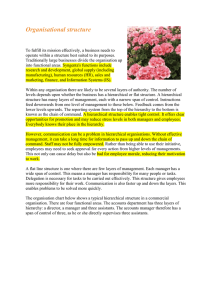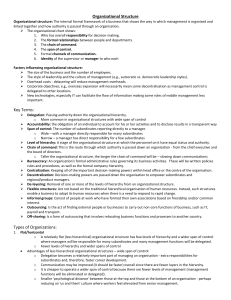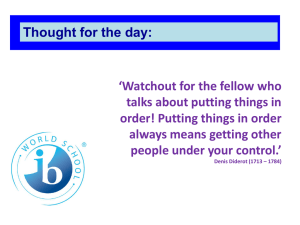2.1.4 - AIS-iGCSE
advertisement

Thought for the day: ‘Watchout for the fellow who talks about putting things in order! Putting things in order always means getting other people under your control.’ Denis Diderot (1713 – 1784) Get an A A Grade Level 4 Evaluation To what extent, Evaluate, discuss, justify, advise, recommend. Apply, Examine, Analyse, Interpret, Formulate. Level 3 Level 2 Level 1 Application & Analysis Understand Knowledge Compare, Contrast, distinguish, prepare, construct, calculate, explain, comment Define, Identify, Complete, Outline, describe, Classify Target Learning Objective Draw, interpret and explain simple organisational charts • Understanding of the roles, responsibilities and interrelationship of people within organisations • Understand the concepts of span of control, hierarchy, chain of command and delegation Comment on the central features of organisational structure • Show analytical awareness of the features of a given chart • Appreciate that organisational charts change as a business expands Who? Keywords ALL Level 1 MOST Level 2 SOME Level 3 &4 De/Centralisation Chain of command Delayering Delegation Organisational chart Responsibility Span of control Organisation Charts All business have an internal structure – the way human resources are organised. This is known as the formal organisation of the business. It takes into account: •The relationship between individuals •Who is in charge •Who has the authority to make decisions •Who carries out decisions •How information is communicated School Organisation Chart Organisation Charts • Organisational charts are used to illustrate the structure of the business. Structure and Hierarchy • .. Are shown by an organisational chart • Traditional business have a series of levels, where each level has a responsibility and authority over level below them. This is called a hierarchy. • An organisational chart sets out who has authority to make decisions and the responsibility for making them. Structure and Hierarchy • It shows who individuals are accountable to – who is directly above them in the hierarchy. Organisation Charts Why have a chart? Why do business draw such charts: • To spot communication problems. • Help individuals see their position in a business • Pinpoint areas where specialists are needed • Show how different sections of the firm relate together Structures can be ‘tall’ or ‘flat’ • Organisations that has lots of levels in their hierarchy are called ‘tall’. They have a large number of people between the ‘top’ and the ‘bottom’. • Tall structures have a long ‘chain of command’ Chain of command The HIERARCHY in a business is the order or levels of management in a business from the lowest to the highest rank. It shows the CHAIN OF COMMAND within the organisation – the way the authority is organised. Orders passed down the levels the information passed up. The chain of command is the communication and authority up and down the hierarchy. Structures can be ‘tall’ or ‘flat’ • If the structure is too tall, it affect communication. • Messages take a long time to get from one end of the chain of command to the other, and they can get distorted along the way. • Decision take a long time to make. • And.. There is a lot of paper work. Structures can be ‘tall’ or ‘flat’ • ‘Flat’ organisations only have a few levels in the hierarchy. • If the structure is too flat, then managers can get overwhelmed by too many people reporting to them. Span of control This refers to the number of subordinates working under a superior or manager. A narrow span of control has the advantage of a firm of close supervision, better coordination of activities, better communication – monitor more closely A wide span of control allows independent decision making. – hard to manage effectively Broad (wide) vs Narrow span of control • Too narrow – staff become de-motivated – being over-managed • Too broad – hard to manage effectively. Activity Construct an organisation chart of AIS. Identify: Chain of command Span of control Delegation Responsibility ‘What are the advantages and disadvantages of this structure?’ Activity Job Roles Investigate: The key responsibility of the following person – • Director • Manager • Employee Plenary Level achieved_____ What do you now know as a result of today’s lesson? What are your areas for improvement? What are you going to do about this?







